Development of Technology for Production of Wear Resistant Cast Products
Saidmakhamadov Nosir, PhD
Tashkent state technical university, University Street 2, Tashkent, Uzbekistan
Turakhodjaev Nodir
DSc professor, Tashkent state technical university, University Street 2, Tashkent, Uzbekistan
Khalimjonov Tokhir
Docent, Tashkent state technical university, University Street 2, Tashkent, Uzbekistan
Abdullaev Kamol
Docent, Namangan engineering construction institute, Islam Karimov street 12, Namangan
Saidkhodjaeva Shokhista
Docent, Tashkent state technical university, University Street 2, Tashkent, Uzbekistan
ANNOTATION
In this article, high chromium 280X29NL malleable white cast iron is produced by reducing the chromium content from 28.86 31% to 16 17%, adding up to 2% Mo, changing its chemical composition, and heat treating the alloy without reducing its mechanical properties. A new brand of wear resistant alloy 280X29NL (sample 1) was developed.
KEYWORDS: alloy, furnace, thermal treatment, white cast iron, CEMCO and BARMAK crushers, supply disc, element, brand, chemical composition, alloy, equipment, microstructure
INTRODUCTION
In today’s world, one of the most important tasks is to increase the strength, quality, and mechanical and operational properties of machine building parts produced by casting. Scientific and research activities carried out in the field of foundry on a global scale, including: development of a high quality and economically inexpensive alloy, taking into account the working environment of ductile white cast irons, without changing the mechanical properties of the alloy depending on the working conditions of the alloy, as well as a new optimum of heat treatment for ductile alloys development and use of standards is considered important [1 3].
Scientific innovations are being made in a number of directions to liquefy ferrous metals and obtain high quality ingots from malleable white cast iron at foundries. In this regard, the USA, Spain, Egypt, Mexico, Russia, Ukraine and other countries are the leaders among the countries that cast malleable white cast iron. From year to year, due to the increase in the amount of production of cast products in the field of foundry, the demand for the quality of details made of malleable white cast iron increases, special attention is paid to the creation of technology for obtaining high quality cast products from malleable white cast iron based on an effective method that ensures resource saving [4 5].
Middle European Scientific Bulletin, VOLUME 25 Jun 2022
After the independence of our republic, with the development of metallurgical, mining and foundry industries, scientific and research work on the production of cast products made of malleable white cast iron, replacing imports, has been carried out and a number of results are being achieved. In this regard, further improvement of the casting technology of malleable cast iron in sand clay moulds, improvement of the quality of the cast products obtained, development of the casting industry based on modern requirements based on the application of new modern technologies of their liquefaction, including the optimal composition of alloys and thermal treatment to increase the malleability of cast products it is required to develop and put into practice the standards [6 9].
MATERIALS AND METHODS
Currently, in the production conditions of the “NMP” enterprise of the “Navoiy MMC” JC, during the process of ore crushing, the defects in the discs of the CEMCO and BARMAK crushers operating on the basis of centrifugal force under high friction conditions and the reasons for their formation were analyzed.
1 picture. View of a failed provisioning disc dump
In Figure 1, the supply disc part used in the production enterprise, after an average of 36 40 operations, the supply disc part became unusable due to friction.
In order to increase the service life of the details, the chemical composition was changed, and the results were obtained. The research works of domestic and foreign manufacturers on cast alloys based on high fructility high chromium cast iron and the research conducted by foreign scientific research institutions and laboratories on extending the service life of cast discs made of high fructility chrome cast iron were analyzed.
In order to increase the service life of the discs of the CEMCO and BARMAK crushers, which work mainly under the influence of centrifugal force, and in order to increase their service life, the chemical composition of the aggregate was developed in order to produce a technology for increasing the ductility of the cast products obtained from ductile white cast iron [10 14]. The chemical composition of the alloy was proposed below and the developed chemical composition is given in Table 1.
Table 1. Chemical composition of the proposed alloy
Brand Elements, %
After coordination of the slag material, it was heated to a temperature of 1400
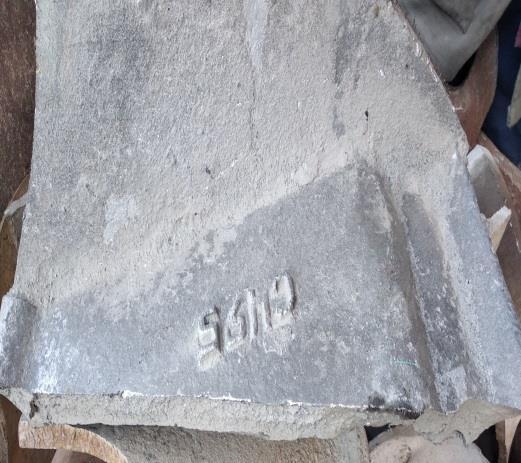
in an IST 0.4 induction furnace, after removing the slag, ferroalloys were introduced, and after holding for 10 minutes, it was poured into a sand clay mold.
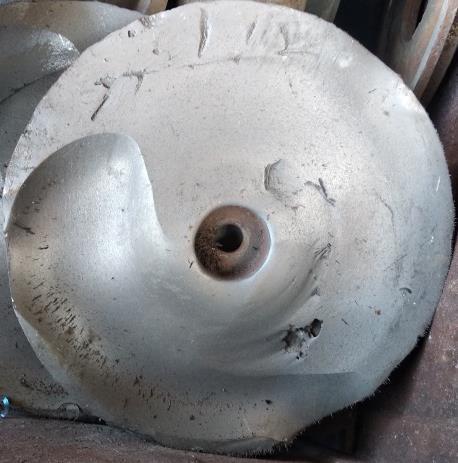
Middle European Scientific Bulletin,
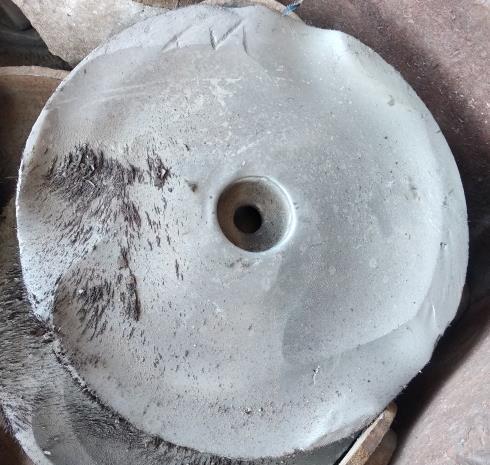
After cooling in cast sand clay mould, it was subjected to mechanical processing and the chemical composition of the alloy was determined by “SPEKTROLAB 10M” equipment.
Table 2. Chemical composition of the sample Brand Elements, % С Si Mn Cr Mo Ni Cu P S Sample 2,87 1,18 0,89 16,53 2.07 0,63 0,61 0,062 0,036
SNOL 7.2/1100 muffle furnace was used for heat treatment to increase the internal structure, physical and mechanical properties of cast alloys. An overview of the resistance furnace is shown in Figure 2.

TK 2M brand hardness measuring device was used to determine the alloy hardness of the obtained samples and METAM РВ 23 brand and scanning electron microscopes were used to analyze the microstructure of the alloy.
RESULT
In order to increase the strength of the supply discs of grinders working under the influence of high stress from ductile white cast iron, for the production of ductile cast iron with a strong and dendritic structure, the chemical composition of the slag material was used to increase their ductility based on alloying elements [15 18]. The obtained results showed that conducting research in this direction can give the expected results.
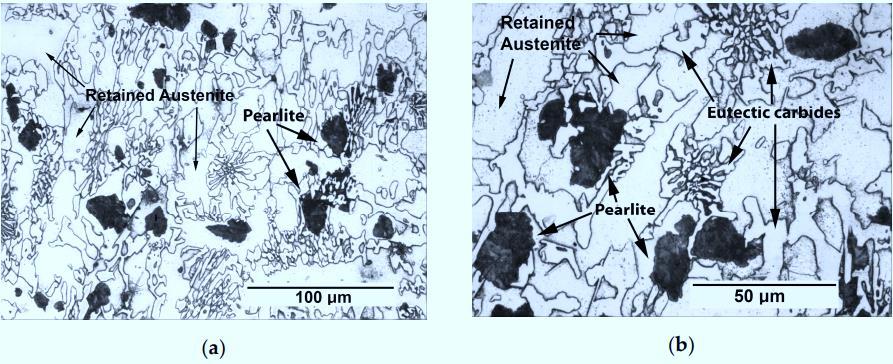
After removing the ductile white cast iron from the casting mold, the alloy was imaged using a scanning electron microscope at x500 and x1000 magnifications.
3 picture. Image taken using a compound scanning electron microscope at a) x500, b) x1000 magnification
Figure 3 shows the microstructure of a ductile white cast iron alloy. The presence of eutectic carbides and pearlite can be observed in the matrix with much residual austenite.
In order to increase the strength and flexibility of the sample, a thermal treatment regime was developed.
1 graph. Graph of thermal treatment of the alloy
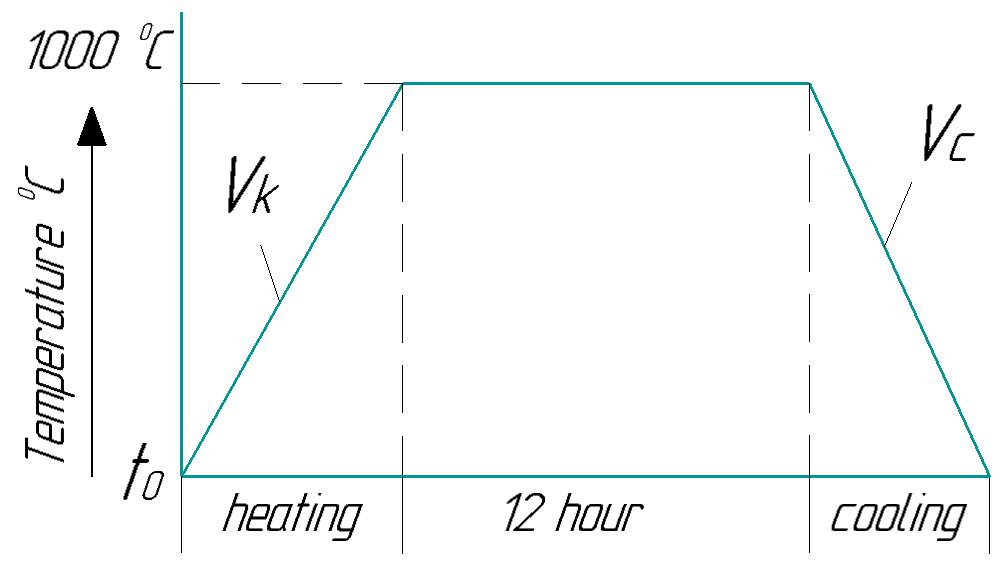
The supply disc detail cast by the casting method was heated to a temperature of 10000 C in the SNOL 7.2/1100 muffle furnace, and then the detail was inserted into the furnace. The procedure can be seen in pictures 4, 5, 6.
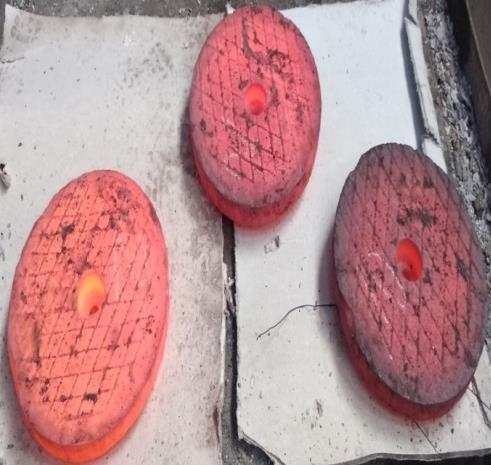
4 picture. The process of loading the supply disc part into the furnace
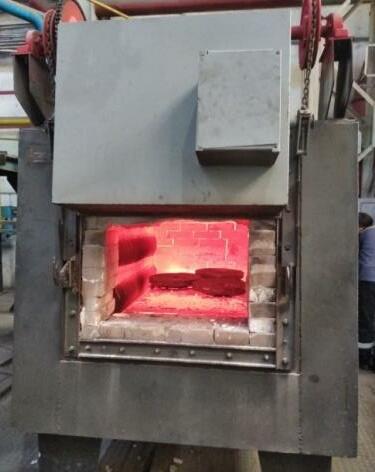
5 picture. Set temperature for thermal operation
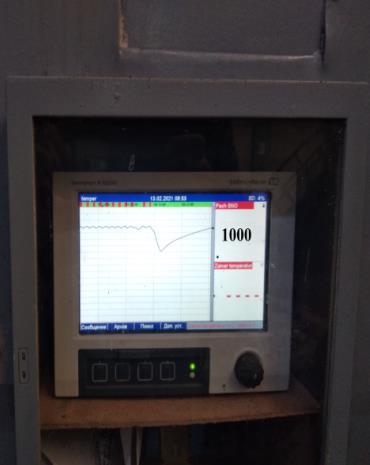
6 picture. The process of cooling the supply disc detail in air
Figure 7 shows the microstructure of austenite destabilization after processing at a temperature of 1000°C. The microstructure consists of proeutectic austenite and a eutectic component, in which austenite formed the matrix phase and the dispersed phase formed M7C3 carbides. In this case, austenite mainly turns into martensite. The presence of secondary carbides mainly preserved the proeutectic austenite and gave it a darker color than the austenite that was part of the eutectic. The high density of secondary carbides in proeutectic austenite is associated with the segregation of Mo, the eutectic component of austenite, which prevented the segregation of secondary carbides in eutectic austenite. When the research result was compared, four kinetic results occurred at the same time.
Middle European Scientific Bulletin, VOLUME 25 Jun 2022
SCIENTIFIC BULLETIN
1. Holding the sample at a temperature of 10000 C for a long time led to an increase in secondary carbides. This increased the temperature of Ms (the temperature at which the transformation of austenite to martensite begins. Ms only means the beginning of martensite) and reduced the residual austenite.

2. It was also observed that eutectic carbides characteristic of non uniform alloy were melted when held at 10000 C for a longer period of time.
3. In addition, during slow cooling in the temperature range of 6000 4000 C, (cooling in the external environment) it was observed that additional secondary carbides were released.
4. However, holding at 10000 C for a long time resulted in burning of the carbon content in the 0.1 mm layer on the surface of the alloy.
7 picture. Scanning electron microscope image of the alloy at x1000 magnification 8 picture. Scanning electron microscope image of the alloy at x1500 magnification
Eutectic and secondary carbides were observed in the microstructures in pictures 7, 8.
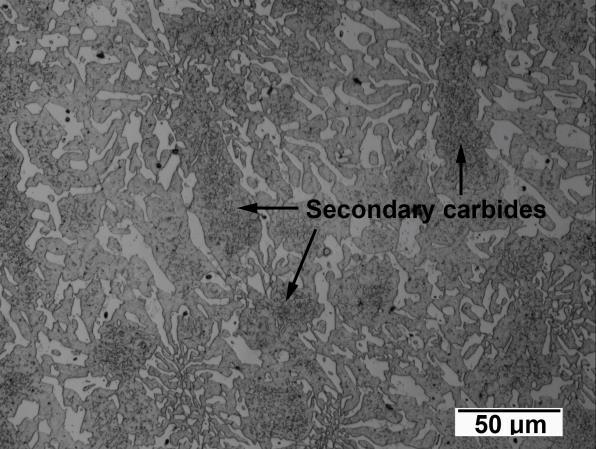
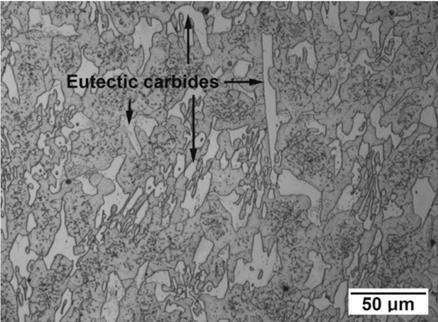
The diffrograms obtained after heat treatment of the alloy used for austenite destabilization are shown in Fig. 9.
9 picture. Diffrogram for a sample collected in air
Middle European Scientific Bulletin, VOLUME 25 Jun 2022
The sample was kept at a temperature of 10000 C for 12 hours, cooled in air, and the diffrogram of the sample was observed, and carbides were observed through the diffrogram.
CONCLUSION
It was concluded as follows to reduce the chromium content of ductile white cast iron and heat treat it to develop an economically inexpensive sample without reducing the mechanical properties of the sample.
1. The longer the exposure time at the temperature at which austenite stabilizes at 10000 C, the greater the amount of secondary carbide. However, it was observed that the proportion of dissolved eutectic carbides was also high. These eutectic carbides are formed by non equilibrium solidification. Low cooling rates (in air) can compensate for this carbide solution by further separating secondary carbides at 600 4000 C.
2. The resistance to erosive cracking is mainly due to the large amount of secondary carbides, resulting from the destabilization of austenite. The maximum bending strength when cooled by air was matched to the machining process to stabilize at 10000 C for 12 hours.
3. As a result of heat treatment at 10000 C for 12 hours, a sharp decrease in the percentage of retained austenite was observed, and the minimum values were around 3%.
4. maximum hardness increase of 46 48 HRC was observed after 12 hours of treatment when the air cooled sample was at stabilization temperature and reduced residual austenite.
REFERENCES
1. Bekmirzaev, S., Saidmakhamadov, N., & Ubaydullaev, M. (2016). Obtaining sand clay casting". Theory and practice of modern. Russia, (4 (12)), 112.
2. Саидмахамадов Н. и др. Технология предотврашения пор в отливах //Экономика и социум. 2019. №. 4. С. 661 672.
Саидмахамадов Н. и др. Общая технология производства порошково констукционных материалов
социум. 2019. №.
С. 673 680.
Н., Хайдаров
Эгамбердиев
Улучшение подготовки технологий методом специального сливания //Экономика и социум. 2019. №. 4. С. 651 660.
Turakhodjaev, N., Saidmakhamadov, N., Turakhujaeva, S., Akramov, M., Turakhujaeva, A., & Turakhodjaeva, F. (2020). Effect of metal
period on product quality. Theoretical & Applied Science, (11), 23 31.
Turakhodjaev, N. D., Saidmakhamadov, N. M., Zokirov, R. S., Odilov, F. U., & Tashkhodjaeva, K. U. (2020). Analysis of defects in white cast iron. Theoretical & Applied Science, (6), 675 682.
Shirinkhon, T., Azizakhon, T., & Nosir, S. (2020). Methods For Reducing Metal Oxidation When Melting Aluminum Alloys. International Journal of Innovations in Engineering Research and Technology, 7(10), 77 82.
8. Djahongirovich, T. N., & Muysinaliyevich, S. N. (2020). Important features of casting systems when casting alloy cast irons in sand clay molds. ACADEMICIA: An International Multidisciplinary Research Journal, 10(5), 1573 1580.
Nodir, T., Nosir, S., Shirinkhon, T., Erkin, K., Azizakhon, T., & Mukhammadali, A. (2021). Development Of Technology To Increase Resistance Of High Chromium Cast Iron. The American Journal of Engineering and Technology, 3(03), 85 92.
Middle European Scientific Bulletin,
10. Nodir T. et al. Development of 280X29Nl Alloy Liquefaction Technology to Increase the Hardness and Corrosion Resistance of Cast Products //International Journal of Mechatronics and Applied Mechanics. 2021. Т. 154. С. 2021.
11. Turakhodjaev N. et al. Quality improvement of the steel melting technology in an electric arc furnace //ACADEMICIA: An International Multidisciplinary Research Journal. 2021. Т. 11. №. 7. С. 48 54.
12. Saidmakhamadov N., Abdullaev K., Khasanov J. Теория
//теория
науки
социально экономического развития".
13. Nosir S. et al. Development of High Chromium White Cast Iron Liquefaction Technology //Eurasian Journal of Engineering and Technology. 2022. Т. 4. С. 123 127.
14. Nosir S. et al. Development of technology for obtaining quality castings from steel alloys //Eurasian Journal of Engineering and Technology. 2022. Т. 5. С. 135 138.
15. Nosir S. et al. Technology for Obtaining High Quality Castings from Resistance White Cast Iron //Eurasian Journal of Engineering and Technology. 2022. Т. 5. С. 139 148.
16. Nosir S. et al. Technology to Increase the Hardness and Resistance of High Chromium White Cast Iron //European Multidisciplinary Journal of Modern Science. 2022. Т. 6. С. 665 670.
17. Turakhodjaev N. et al. Quality improvement of the steel melting technology in an electric arc furnace //ACADEMICIA: An International Multidisciplinary Research Journal. 2021. Т. 11. №. 7. С. 48 54.
18. Turakhodjaev N. et al. Technology for Cleaning Non Metallic Inclusions and Gaseous Pores in the Process of Liquefaction of Steels in an Electric Arc Furnace //European Multidisciplinary Journal of Modern Science. 2022. Т. 4. С. 77 82.
